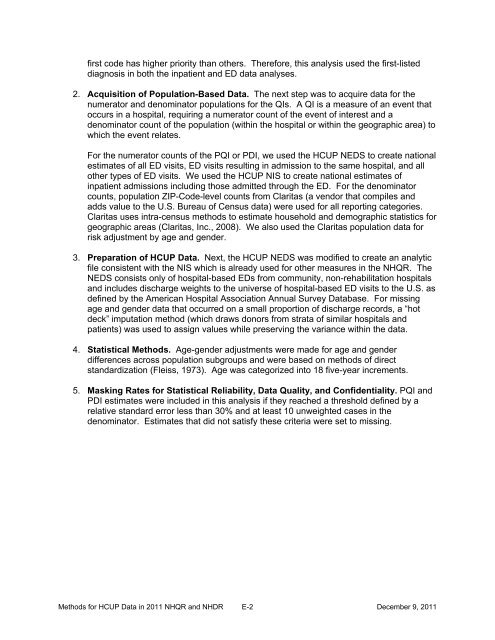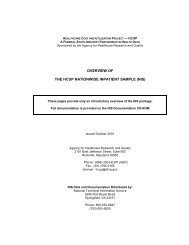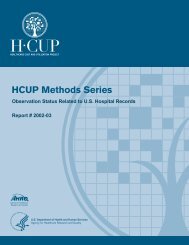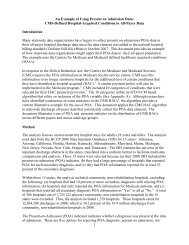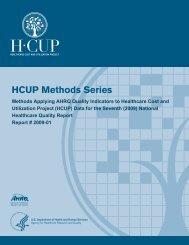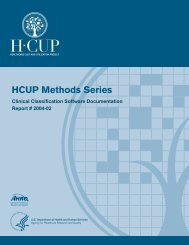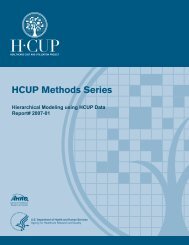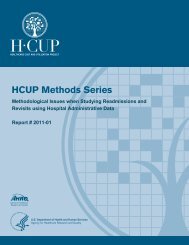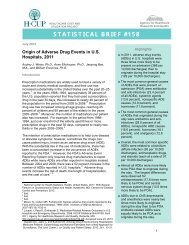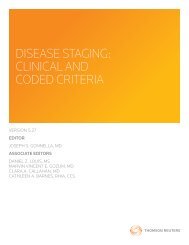Methods Applying AHRQ Quality Indicators to Healthcare ... - HCUP
Methods Applying AHRQ Quality Indicators to Healthcare ... - HCUP
Methods Applying AHRQ Quality Indicators to Healthcare ... - HCUP
Create successful ePaper yourself
Turn your PDF publications into a flip-book with our unique Google optimized e-Paper software.
first code has higher priority than others. Therefore, this analysis used the first-listeddiagnosis in both the inpatient and ED data analyses.2. Acquisition of Population-Based Data. The next step was <strong>to</strong> acquire data for thenumera<strong>to</strong>r and denomina<strong>to</strong>r populations for the QIs. A QI is a measure of an event tha<strong>to</strong>ccurs in a hospital, requiring a numera<strong>to</strong>r count of the event of interest and adenomina<strong>to</strong>r count of the population (within the hospital or within the geographic area) <strong>to</strong>which the event relates.For the numera<strong>to</strong>r counts of the PQI or PDI, we used the <strong>HCUP</strong> NEDS <strong>to</strong> create nationalestimates of all ED visits, ED visits resulting in admission <strong>to</strong> the same hospital, and allother types of ED visits. We used the <strong>HCUP</strong> NIS <strong>to</strong> create national estimates ofinpatient admissions including those admitted through the ED. For the denomina<strong>to</strong>rcounts, population ZIP-Code-level counts from Claritas (a vendor that compiles andadds value <strong>to</strong> the U.S. Bureau of Census data) were used for all reporting categories.Claritas uses intra-census methods <strong>to</strong> estimate household and demographic statistics forgeographic areas (Claritas, Inc., 2008). We also used the Claritas population data forrisk adjustment by age and gender.3. Preparation of <strong>HCUP</strong> Data. Next, the <strong>HCUP</strong> NEDS was modified <strong>to</strong> create an analyticfile consistent with the NIS which is already used for other measures in the NHQR. TheNEDS consists only of hospital-based EDs from community, non-rehabilitation hospitalsand includes discharge weights <strong>to</strong> the universe of hospital-based ED visits <strong>to</strong> the U.S. asdefined by the American Hospital Association Annual Survey Database. For missingage and gender data that occurred on a small proportion of discharge records, a “hotdeck” imputation method (which draws donors from strata of similar hospitals andpatients) was used <strong>to</strong> assign values while preserving the variance within the data.4. Statistical <strong>Methods</strong>. Age-gender adjustments were made for age and genderdifferences across population subgroups and were based on methods of directstandardization (Fleiss, 1973). Age was categorized in<strong>to</strong> 18 five-year increments.5. Masking Rates for Statistical Reliability, Data <strong>Quality</strong>, and Confidentiality. PQI andPDI estimates were included in this analysis if they reached a threshold defined by arelative standard error less than 30% and at least 10 unweighted cases in thedenomina<strong>to</strong>r. Estimates that did not satisfy these criteria were set <strong>to</strong> missing.<strong>Methods</strong> for <strong>HCUP</strong> Data in 2011 NHQR and NHDR E-2December 9, 2011


